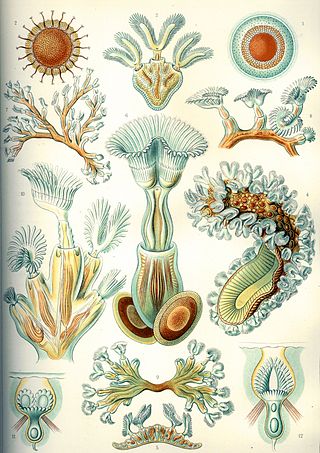
Bryozoa are a phylum of simple, aquatic invertebrate animals, nearly all living in sedentary colonies. Typically about 0.5 millimetres long, they have a special feeding structure called a lophophore, a "crown" of tentacles used for filter feeding. Most marine bryozoans live in tropical waters, but a few are found in oceanic trenches and polar waters. The bryozoans are classified as the marine bryozoans (Stenolaemata), freshwater bryozoans (Phylactolaemata), and mostly-marine bryozoans (Gymnolaemata), a few members of which prefer brackish water. 5,869 living species are known. Originally all of the crown group Bryozoa were colonial, but as an adaptation to a mesopsammal life or to deep-sea habitats, secondarily solitary forms have since evolved. Solitary species has been described in four genera; Aethozooides, Aethozoon, Franzenella and Monobryozoon). The latter having a statocyst-like organ with a supposed excretory function.

The Sipuncula or Sipunculida is a class containing about 162 species of unsegmented marine annelid worms. Sipuncula was once considered a phylum, but was demoted to a class of Annelida, based on recent molecular work.
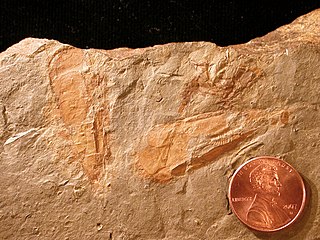
Hyoliths are animals with small conical shells, known from fossils from the Palaeozoic era. They are at least considered as being lophotrochozoan, and possibly being lophophorates, a group which includes the brachiopods, while others consider them as being basal lophotrochozoans, or even molluscs.

Bilateria is a large clade or infrakingdom of animals called bilaterians, characterized by bilateral symmetry during embryonic development. This means their body plans are laid around a longitudinal axis with a front and a rear end, as well as a left–right–symmetrical belly (ventral) and back (dorsal) surface. Nearly all bilaterians maintain a bilaterally symmetrical body as adults; the most notable exception is the echinoderms, which extend to pentaradial symmetry as adults, but are only bilaterally symmetrical as an embryo. Cephalization is also a characteristic feature among most bilaterians, where the special sense organs and central nerve ganglia become concentrated at the front/rostral end.

A body cavity is any space or compartment, or potential space, in an animal body. Cavities accommodate organs and other structures; cavities as potential spaces contain fluid.

Yunnanozoon lividum is an extinct species of bilaterian animal from the Lower Cambrian Chengjiang biota of Yunnan province, China. Its affinities have been long the subject of controversy.
Pikaia gracilens is an extinct, primitive chordate animal known from the Middle Cambrian Burgess Shale of British Columbia. Described in 1911 by Charles Doolittle Walcott as an annelid, and in 1979 by Harry B. Whittington and Simon Conway Morris as a chordate, it became "the most famous early chordate fossil", or "famously known as the earliest described Cambrian chordate". It is estimated to have lived during the latter period of the Cambrian explosion. Since its initial discovery, more than a hundred specimens have been recovered.
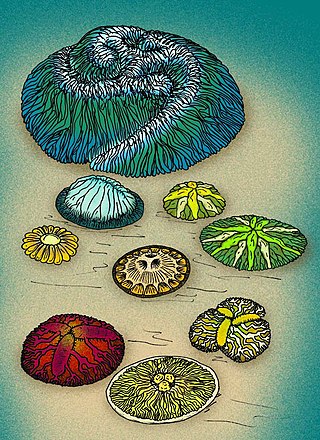
Trilobozoa is a phylum of extinct, sessile animals that were originally classified into the Cnidaria. The basic body plan of trilobozoans is often a triradial or radial sphere-shaped form with lobes radiating from its centre. Fossils of trilobozoans are restricted to marine strata of the Late Ediacaran period.
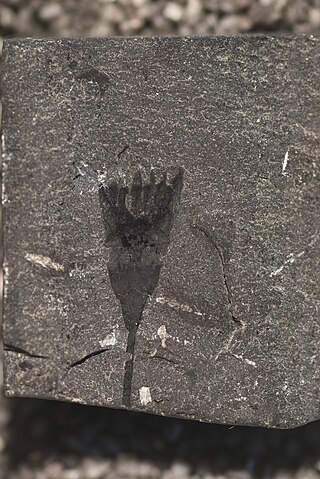
Dinomischusis an extinct genus of stalked filter-feeding animals within the Cambrian period, with specimens known from the Burgess Shale and the Maotianshan Shales. While long of uncertain affinities, recent studies have suggested it to be a stem-group ctenophore.

Phoronids are a small phylum of marine animals that filter-feed with a lophophore, and build upright tubes of chitin to support and protect their soft bodies. They live in most of the oceans and seas, including the Arctic Ocean but excluding the Antarctic Ocean, and between the intertidal zone and about 400 meters down. Most adult phoronids are 2 cm long and about 1.5 mm wide, although the largest are 50 cm long.
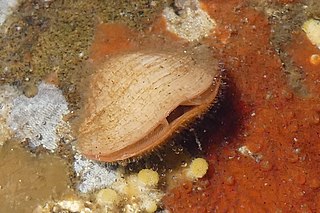
Brachiopods, phylum Brachiopoda, are a phylum of trochozoan animals that have hard "valves" (shells) on the upper and lower surfaces, unlike the left and right arrangement in bivalve molluscs. Brachiopod valves are hinged at the rear end, while the front can be opened for feeding or closed for protection. Two major categories are traditionally recognized, articulate and inarticulate brachiopods. The word "articulate" is used to describe the tooth-and-groove structures of the valve-hinge which is present in the articulate group, and absent from the inarticulate group. This is the leading diagnostic skeletal feature, by which the two main groups can be readily distinguished as fossils. Articulate brachiopods have toothed hinges and simple, vertically oriented opening and closing muscles. Conversely, inarticulate brachiopods have weak, untoothed hinges and a more complex system of vertical and oblique (diagonal) muscles used to keep the two valves aligned. In many brachiopods, a stalk-like pedicle projects from an opening near the hinge of one of the valves, known as the pedicle or ventral valve. The pedicle, when present, keeps the animal anchored to the seabed but clear of sediment which would obstruct the opening.

Eldonia is an extinct soft-bodied cambroernid animal of unknown affinity, best known from the Fossil Ridge outcrops of the Burgess Shale, particularly in the 'Great Eldonia layer' in the Walcott Quarry. In addition to the 550 collected by Walcott, 224 specimens of Eldonia are known from the Greater Phyllopod bed, where they comprise 0.43% of the community. Species also occur in the Chengjiang biota, Siberia, and in Upper Ordovician strata of Morocco.

The Asterozoa are a subphylum in the phylum Echinodermata. Characteristics include a star-shaped body and radially divergent axes of symmetry. The subphylum includes the class Asteroidea, the class Ophiuroidea, and the extinct order Somasteroidea.

Herpetogaster is an extinct cambroernid genus of animal from the Early Cambrian Chengjiang biota of China, Blang Formation of China, Pioche Formation of Nevada and Middle Cambrian Burgess Shale of Canada containing the species Herpetogaster collinsi and Herpetogaster haiyanensis.

Stellostomites is a discoidal animal known from the Cambrian Chengjiang biota and classified with the eldoniids.

Rotadiscus is a genus of discoidal animal known from the Cambrian Chengjiang biota and classified with the eldonioids.

Phlogites, a senior synonym of Cheungkongella ancestralis, is a cambroernid, and thus a member of the deuterostome total group. It is known from the Lower Cambrian Haikou Chengjiang deposits of China, and was initially compared to the tunicates. It was originally described as a tunicate, though, this identification has been questioned, especially with the discovery of another Chengjiang tunicate, Shankouclava. It has most recently been interpreted as a cambroernid related to Eldonia, Rotadiscus and Herpetogaster.

The cambroernids are a clade of unusual Paleozoic animals with coiled bodies and filamentous tentacles. They include a number of early to middle Paleozoic genera noted as "bizarre" or "orphan" taxa, meaning that their affinities with other animals, living or extinct, have long been uncertain. While initially defined as an "informal stem group," later work with better-preserved fossils has strengthened the argument for Cambroernida as a monophyletic clade.
Phoronis psammophila is a species of marine horseshoe worm in the phylum Phoronida. It lives in a tube projecting from the sea floor in shallow seas around the world.

Cincta is an extinct class of echinoderms that lived only in the Middle Cambrian epoch. Homostelea is a junior synonym. The classification of cinctans is controversial, but they are probably part of the echinoderm stem group.




















